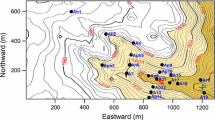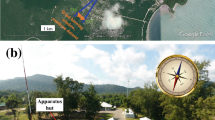Abstract
A detailed analysis of two nighttime drainage wind events that commenced on the evenings of 7 and 8 October, 1980 is presented. Data on wind velocity and temperature (10-s values), obtained from each of the eight instrumented levels of the Boulder Atmospheric Observatory, are used to construct 10-min means and root-mean-square values of all the variables. Additional information is provided by acoustic sounder data for 8 October.
The analyses reveal that the passage of the drainage front occurs abruptly, between two 10-s observations, on both days. Relatively intense root-mean-square variability in the velocity and temperature fields accompanies the passage of the drainage front. In addition, the undercutting cold drainage air initiates significant variability in the vertical velocity field that extends above the 300 m level of the tower. The most significant variability in the other meteorological fields is primarily restricted to the lowest 150 m with the passage of the drainage front.
A principal feature of the analysis is the delineation of Kelvin-Helmholtz instability and billow development, breakdown into turbulence and ultimate decay to a less turbulent state that occurs intermittently behind the drainage front. These features are interpreted in light of Thorpe's (1973a, b) experimental work on stability and turbulence in stratified shear flow and the predictions of linear instability theory. The interpretations are carried out by considering the distributions of the Richardson number, the peak shears of the mean flow and the vertical fluxes of horizontal momentum associated with the unstable growth of the disturbances. Additional comparisons are made between the turbulent structures in Thorpe's laboratory experiments and the turbulence exhibited in traces of the 10-s vertical velocity data measured at various levels both above and below the interface.
The relevance of the present results to the design of future field programs, and to the observational data requirements that should be met to incorporate turbulent entrainment processes in models of pollutant dispersal is discussed.
Similar content being viewed by others
References
Bevington, P. R.: 1969, Data Reduction and Error Analysis for the Physical Sciences, McGraw-Hill, 336 pp.
Browning, K. A.: 1971, ‘Structure of the Atmosphere in the Vicinity of Large-Amplitude Kelvin-Helmholtz Billows’, Quart. J. Roy. Meteorol. Soc. 97, 283–299.
Davis, P. A. and Peltier, W. R.: 1977, ‘Effects of Dissipation on Parallel Shear Instability near the Ground’, J. Atmos. Sci. 34, 1868–1884.
Emmanuel, C. B., Bean, B. R., McAllister, L. G., and Pollard, J. R.: ‘Observations of Helmholtz Waves in the Lower Atmosphere with an Acoustic Sounder’, J. Atmos. Sci. 29, 886–892.
Hahn, C. J.: 1981, ‘A Study of the Diurnal Behavior of Boundary-Layer Winds at the Boulder Atmospheric Observatory’, Boundary-Layer Meteorol. 21, 231–245.
Hootman, B. W. and Blumen, W.: 1983, ‘Analysis of Nighttime Drainage Winds in Boulder, Colorado, During 1980’, Mon. Wea. Rev. 111, 1052–1061.
Kaimal, J. C. and Gaynor, J. E.: 1983, ‘The Boulder Atmospheric Observatory’, J. Clim. Appl. Meteorol. 22, 863–880.
Mahrt, L. and Larsen, 1982, ‘Small Scale Drainage Front’, Tellus 34, 579–587.
Manins, P. C. and Sawford, B. L.: 1979, ‘Katabatic Winds: A field Case Study’, Quart. J. Roy. Meteorol. Soc. 105, 1011–1025.
Moore, M. J. and Long, R. R.: 1971, ‘An Experimental Investigation of Turbulent Stratified Shearing Flow’, J. Fluid Mech. 49, 635–655.
Simpson, J. E. and Britter, R. E.: 1979, ‘The Dynamics of the Head of a Gravity Current Advancing over a Horizontal Surface’, J. Fluid Mech. 94, 477–495.
Simpson, J. E. and Britter, R. E.: 1980, ‘A Laboratory Model of an Atmospheric Mesofront’, Quart. J. Roy. Meteorol. Soc. 106, 485–500.
Thorpe, S. A.: 1973a, ‘Turbulence in Stably Stratified Fluids: A Review of Laboratory Experiments’, Boundary-Layer Meteorol. 5, 95–119.
Thorpe, S. A.: 1973b ‘Experiments on Instability and Turbulence in a Stratified Shear Flow’, J. Fluid Mech. 61, 731–751.
Wilkinson, D. L. and Wood, I. R.: 1972, ‘Some Observations on the Motion of the Head of a density Current’, J. Hydraul. Res. 10, 305–324.
Woods, J. D.: 1969, ‘On Richardson's Number as a Criterion for Laminar-Turbulent-Laminar Transition in the Ocean and Atmosphere’, Radio Science 4, 1289–1298.
Zamora, R. J.: 1983, ‘Richardson Number Computations in the Planetary Boundary Layer’, in J. C. Kaimal (ed.), Studies of Nocturnal Stable Layers at BAO, U.S. Dept. of Commerce, NOAA/ERL Wave Propagation Laboratory, Boulder, Colo., pp. 109–129.
Author information
Authors and Affiliations
Rights and permissions
About this article
Cite this article
Blumen, W. An observational study of instability and turbulence in nighttime drainage winds. Boundary-Layer Meteorol 28, 245–269 (1984). https://doi.org/10.1007/BF00121307
Revised:
Issue Date:
DOI: https://doi.org/10.1007/BF00121307




